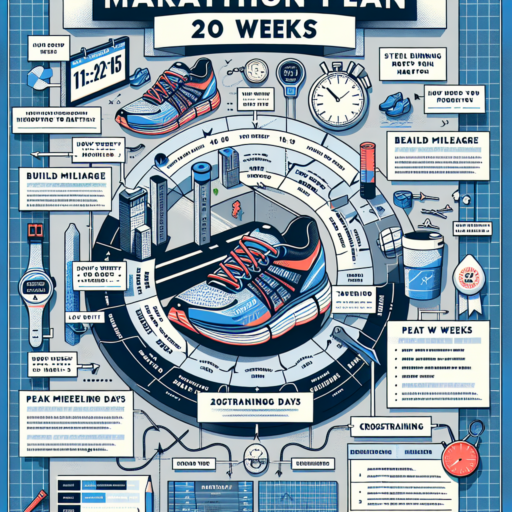What is the strategy for a sub 4 hour marathon?
Achieving a marathon in under four hours is a milestone that many runners aim for, symbolizing a significant level of endurance and speed. The strategy to conquer this goal involves a blend of consistent training, proper pacing, and nutrition. Understanding how to balance these elements can make the journey to breaking the four-hour barrier less daunting and more achievable.
Training and Preparation
Training is the cornerstone of any marathon success. A comprehensive training plan for a sub 4-hour marathon typically spans 16 to 20 weeks, emphasizing gradual mileage increase, speed work, and long runs. It’s crucial to incorporate rest days and cross-training to prevent injuries and enhance overall fitness. Ensuring your body is well-adapted to the rigors of the marathon distance is imperative for not just finishing but doing so within your target time frame.
Pacing Strategy
Pacing is pivotal when targeting a sub 4 hour marathon. Runners should aim for a consistent pace that aligns with their training and fitness level, usually between 9:00 and 9:09 minutes per mile. It’s essential to avoid starting too fast, a common mistake that can lead to early fatigue and a challenging second half. Practicing your target pace during long training runs will help your body and mind prepare for maintaining it on race day.
Nutrition and Hydration
Equally important is a solid nutrition and hydration strategy. The right balance of carbs, proteins, and fats in the months leading up to the race, and a well-practiced hydration and fueling plan for race day, are key. Runners should experiment with different energy gels, bars, and drinks during their training to discover what works best for them, minimizing the risk of gastrointestinal distress while maintaining high energy levels throughout the race.
How many miles per week for a sub-4 hour marathon?
Training for a sub-4 hour marathon is a significant commitment, and one of the most common questions runners have is about the optimal weekly mileage. While there’s no one-size-fits-all answer, certain benchmarks and strategies can guide runners towards achieving their goal. Understanding the balance between mileage, intensity, and recovery is essential in this pursuit.
Generally, aspiring sub-4 marathoners should aim to gradually increase their weekly mileage over the course of their training. For most, this means running anywhere from 30 to 50 miles per week at the peak of their training cycle. It’s crucial to build this mileage progressively to avoid injury and to allow the body to adapt to the increasing demands. Incorporating a mix of long runs, tempo runs, and speed work within these weekly miles is also beneficial for improving endurance and speed.
Key Components of Weekly Mileage
- Long Runs: One long run per week that gradually increases in distance, peaking at 18-22 miles.
- Tempo Runs: These are run at a steady, challenging pace that simulates race conditions, improving both mental and physical endurance.
- Speed Work: Sessions like intervals or hill repeats to enhance speed, efficiency, and strength.
- Recovery Runs: Easy, low-intensity runs that promote recovery while still contributing to your weekly mileage goal.
Adapting your weekly mileage to include these components can make a significant difference in your training efficacy. Balance and consistency in training, along with listening to your body and allowing for adequate rest and recovery, are as critical as the miles themselves for crossing the finish line in under four hours.
No se han encontrado productos.
How many people can run a sub-4 hour marathon?
The quest to run a marathon under 4 hours is a significant milestone for many amateur runners around the world. This benchmark is not only a testament to physical endurance but also to the dedication and training it takes to achieve such a feat.
Understanding the Statistics
According to various marathon participation reports, it’s estimated that approximately 40% of male marathon runners and 25% of female marathon runners can finish a marathon in less than 4 hours. This disparity highlights the different physiological aspects that may influence marathon times between genders. However, it’s essential to note that with proper training and strategy, runners from both genders have consistently broken this barrier.
Factors That Influence Marathon Times
Several factors can impact a runner’s ability to finish a marathon in under 4 hours. Training routines, nutrition, and even the marathon course itself play significant roles. For example, a flat and fast course like the Berlin Marathon may offer more runners the chance to hit their sub-4-hour goal compared to more challenging courses with significant elevation changes.
In conclusion, while the achievement of completing a marathon in less than 4 hours is ambitious, it’s within reach for a significant portion of the running community. With the right preparation and determination, many can join the ranks of those who have achieved this impressive running milestone.
How many gels for a 4 hour marathon?
Planning your nutrition for a 4-hour marathon is crucial for maintaining energy levels and ensuring a successful race. A common question among runners is about the optimal number of energy gels to consume during such an endurance challenge. Understanding how these gels work and balancing their intake can make a significant difference in your performance.
Typically, a runner might need to consume between 1 to 2 energy gels per hour, depending on various factors including their metabolism, the weather, and their individual response to gels. This means for a 4-hour marathon, aiming for 4 to 8 gels throughout the race is a starting point. However, it’s important to factor in your personal tolerance and the concentration of glucose or carbohydrates in the gel.
Moreover, timing the intake of these gels is as critical as the quantity. Starting your gel consumption 30 to 45 minutes into the race can prevent early fatigue and maintain a steady supply of energy. Pairing gels with water rather than sports drinks is advisable to avoid overconsumption of carbohydrates, which can lead to discomfort or gastrointestinal distress.




